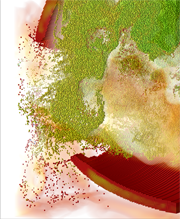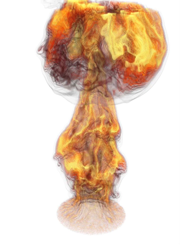Combustion
DOE's investment in combustion modeling is aimed at improving the efficiency of the combustion process, reducing the resulting pollution byproducts, and improving safety and achieving other related objectives. This investment is spread across several different research groups, each using a different theoretical and computational approach.
Despite the differences in approach, these stakeholders have common needs in terms of data analysis, efficient data access, visualization and analysis. To meet the data understanding needs of all stakeholders, VACET must provide:
- full-featured, robust visualization applications capable of processing time varying AMR data with effective resolutions of up to 4096and upwards of 80 variables per grid point;
- specialized "simulation dump" libraries for fast I/O and direct storage in compressed and multi-resolution streaming formats;
- remote and collaborative visualization of large simulation models;
- the ability to track individual atoms over time and to show their location in the computational grid;
- topological and semantic-range query-based feature identification and tracking;
- temporal feature analysis and visualization;
- effective 3D/4D vector field visualization;
- feature mining and visual correlation to show the evolution of derived quantities and statistical moments over time;
- new domain-specific visualization techniques like visual display of species traversing a chemical reaction network in conjunction with traditional 2D and 3D visualization;
- integrating new capabilities with emerging workflow management technologies;
- multi-field visualization and analysis.
See Gallery: Combustion













